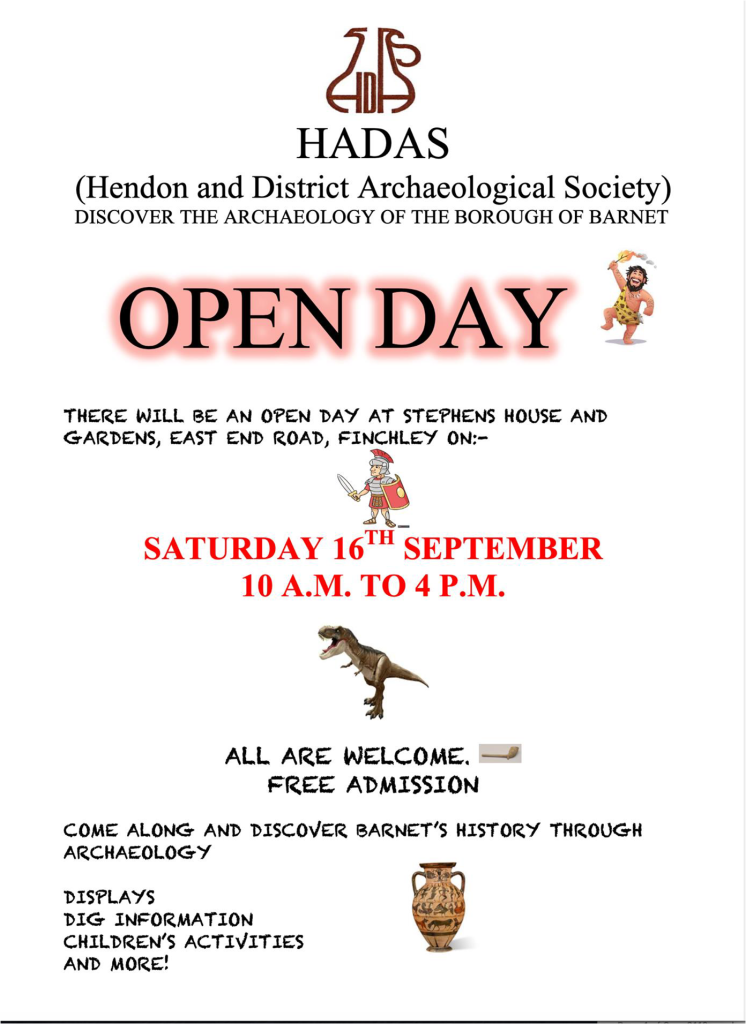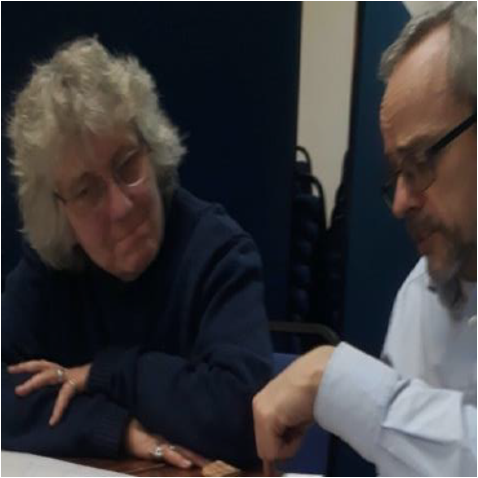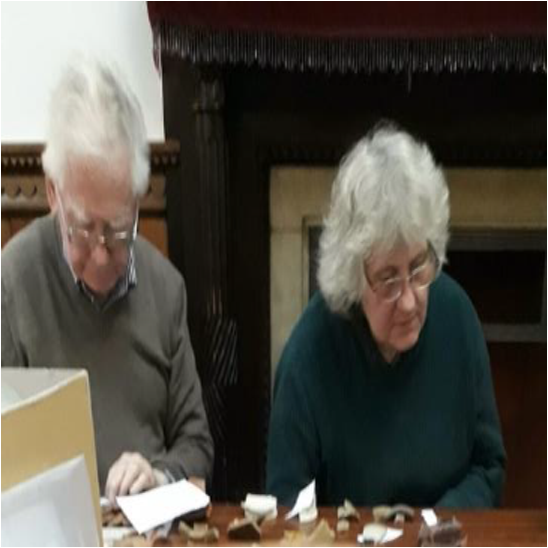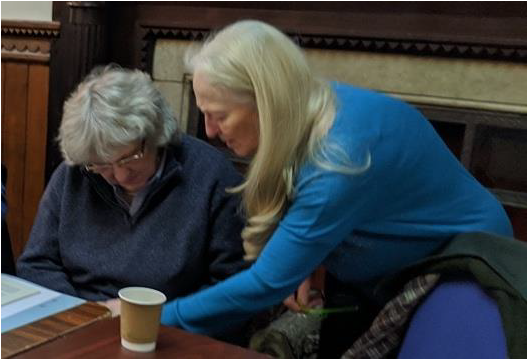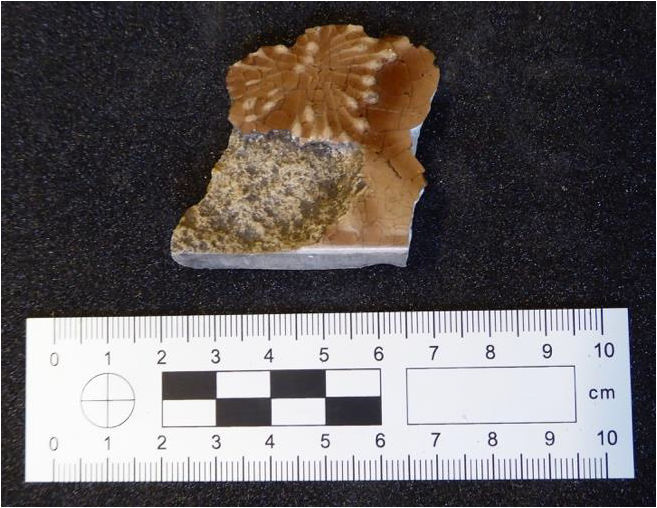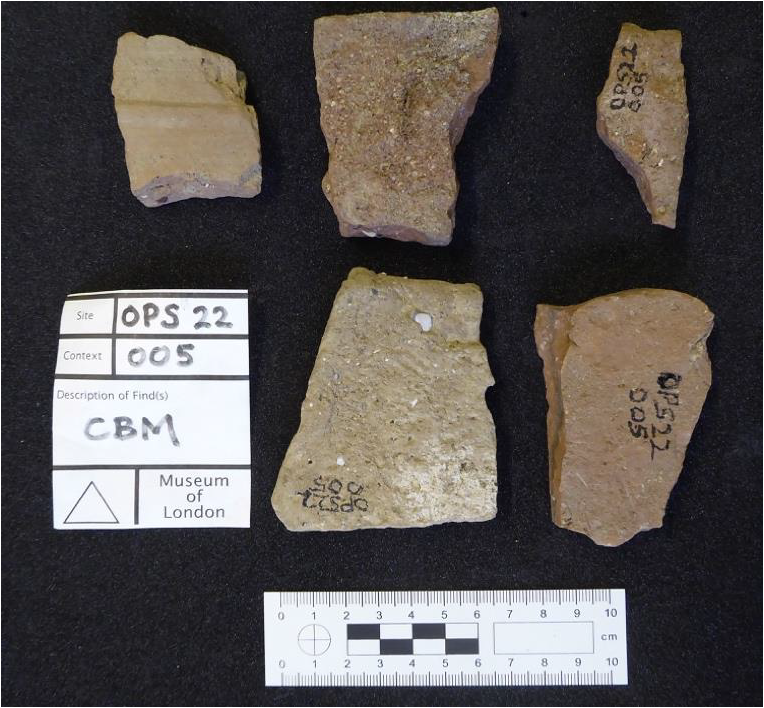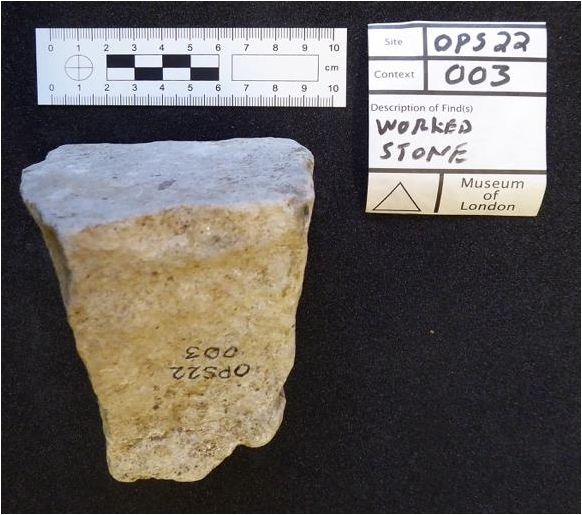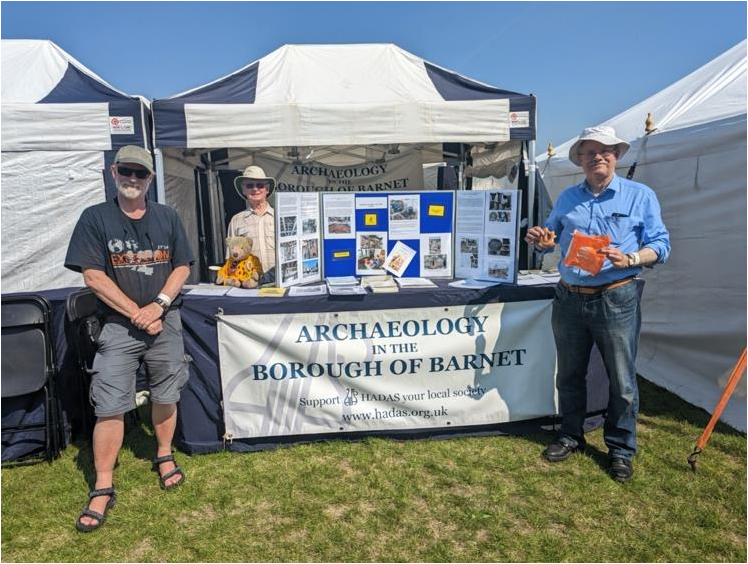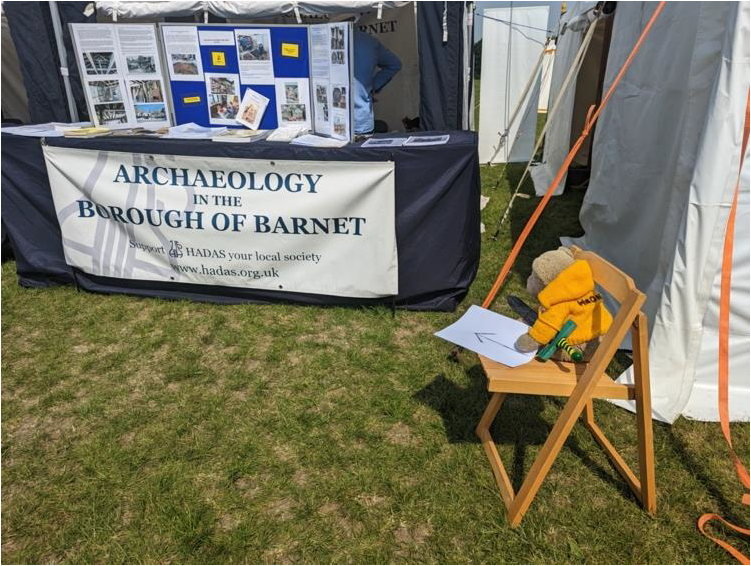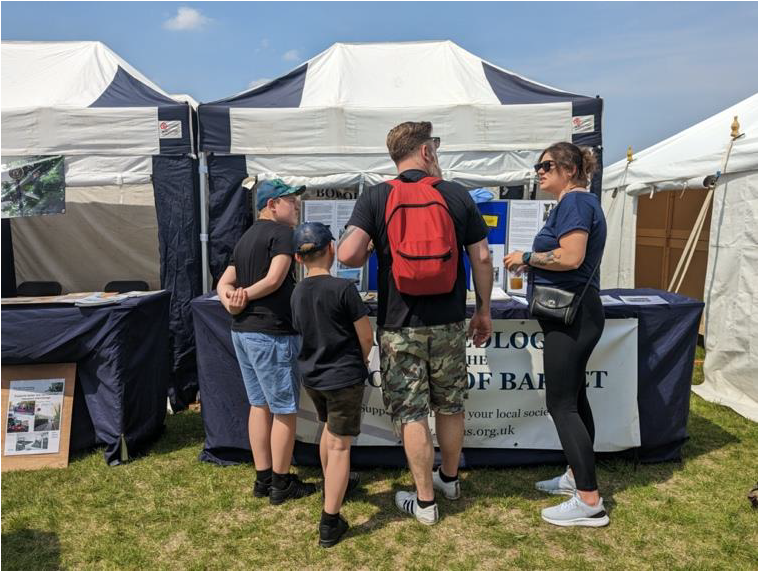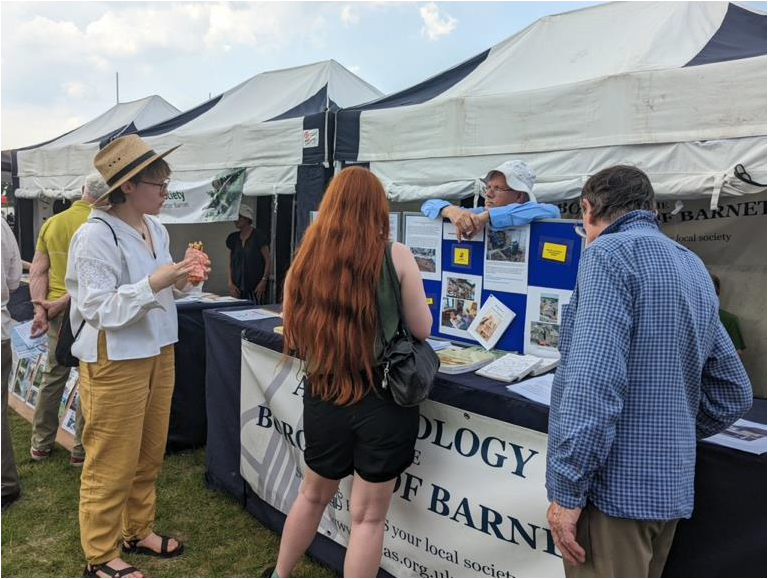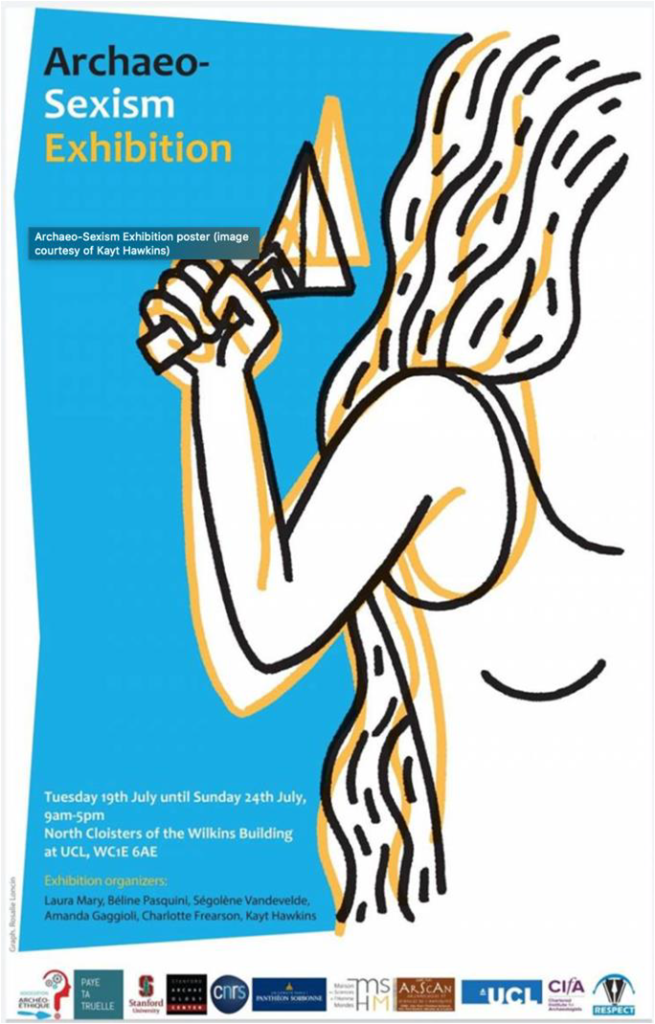
No. 628 July 2023 Edited by Melvyn Dresner
HADAS DIARY – Forthcoming Lectures and Events
Lectures, which are currently not on Zoom, are held in the Drawing Room, Avenue House, 17 East End Road, Finchley N3 3QE. 7.45 for 8pm. Tea/Coffee/biscuits available for purchase after each talk. (Cash please.)
Buses 13, 143, 125, 326 and 460 pass close by Avenue House, and it is a five to ten-minute walk from Finchley Central Station on the Barnet Branch of the Northern Line. Bus 382 passes close to Finchley Central Station.
Tuesday 12th September 2023 Mike Noronha, Barnet Museum
The Battle of Barnet Survey and Project
Tuesday 10th October 2023 Lecture to be arranged
Tuesday 14th November 2023 Kris Lockyear
Mapping Verulamium
__________________________________________________________________________________________
Saturday 16th September HADAS “Open Day” at Avenue House
See poster below
__________________________________________________________________________________________
Subscriptions by Cheque
The annual subscription was due on the 1/4/2023. Members who pay by cheque and have not yet sent their cheque, please address it to:
HADAS
C/o Avenue House, 17 East End Road, Finchley. London N3 3QE
If you have sent your cheque to Steve Brunning’s old address, please let us know.
1
No Dinosaurs were hurt in the making of this poster, if you want to help let us know. It’s archaeology not paleontology. We know you know.
*************************************************************************
2
Welcome to new President of HADAS, thank you to Harvey Sheldon
At this year’s AGM, we said farewell to our President, Harvey Sheldon, and welcomed Jacqui Pearce as our new President.
Harvey has been our President for over twenty years, he has been involved in London archaeology since the early 1960s. He was Field Officer for the Southwark and Lambeth Archaeological Committee from 1972 until 1975, then Head of the Department of Greater London Archaeology in the Museum of London from its establishment in 1975 until 1991. He was part-time tutor in the Department of Extra-Mural Studies University of London, and later, in the Faculty of Continuing Education, Birkbeck, University of London. From the late 1990s until 2010 he had responsibilities for the faculty’s archaeological field programme and for the direction of its MA in Field Archaeology, where many HADAS members participated.
Jacqui has led and tutored HADAS members on our finds course for more than 15 years, including work on sites dug by HADAS members in Southwark with Birkbeck and Harvey. Jacqui is a Senior Finds Specialist with MOLA and an internationally renowned expert in medieval and later ceramics, glass and clay tobacco pipes. She has wide ranging experience of medieval and later pottery and has been involved in the establishment and maintenance of the MOLA Fabric Reference Collection, the main pottery type-series for the London area. In addition, she has developed a detailed recording system for clay pipes in line with national guidelines and that was instrumental in the establishment of the Museum of London’s Clay Tobacco Pipe Makers’ Marks website. Jacqui is the author of numerous major papers and books, including four parts of an extensive Type-series of London Medieval Pottery, the latest of which covers shelly-sandy wares and greywares. She was Joint Editor of Post-Medieval Archaeology from 2009-2014 and is a committee member of the English Ceramic Circle, and Trustee of the National Clay Tobacco Pipe Archive. She is a frequent public speaker, leads workshops, and teaches evening classes in archaeological finds work and publication. In 2011 she was awarded the Ralph Merrifield Prize for Services to London Archaeology.
She was President of the Society for Post-Medieval Archaeology from 2017 to 2021 and is currently Vice President. She is also Co-Editor of English Ceramic Circle Transactions.
Jacqui at the HADAS finds group.
3
AGM Lecture
After tea, coffee and biscuits, our new President, Jacqui Pearce, took us through the top archaeological ceramics from 50 years of digs in London. Starting from the Department of Urban Archaeology in 1974 up to her work today with Museum of London Archaeology (MOLA).
She explained how important were the pottery finds associated with revetments along the north bank of Thames providing a good basis for securely dating London ceramics found in other parts of London. This is related to direct dating such as dendrochronology and relative dating.
Early pots dated to the period of King Alfred were hand built and shell-tempered ceramic, which continued through Saxo-Norman period. Some wares from Stamford entered London in this period. These were high status pottery, lead glazed earthenware, made in Lincolnshire. Forms included spouted pitchers depicting birds. This type of pottery and the techniques are the earliest example of wheel thrown ware.
The beginning of London-type ware emerges late 11th century and early 12th century, wheel thrown, white slip and glaze, also tripod jugs with white and red. This was influenced by north French whitewares particularly from Rouen, with white slip on redware pot with green glaze. We also had London potters moving to Kingston in this period, and making decorated pots for the London markets, often decorated in flowers. These included zoomorphic forms such as griffins, including forms and decorations copying metal forms. As well as this higher status decorated wares, examples recovered from cesspits (Cannon Street), we also had emergence of south Hertfordshire greyware (SHER), typical forms include cooking pots, also course border ware. Border ware is from Surrey-Hampshire. We had a unique example of a horse head, probably a gaming piece. They also include crude human forms and animals, and face jugs, copying German stoneware. Also higher quality forms such as Edward II, probably made from a mould.
Jacqui took us through the story of ceramic finds in London, into the early modern period, including stone ware linked to trade via the Hanseatic League via money boxes found at the Rose Theatre, and like many things ending in chamber pots.
Pots from MOLA website https://www.mola.org.uk/type-series-medieval-pottery-archaeological-services
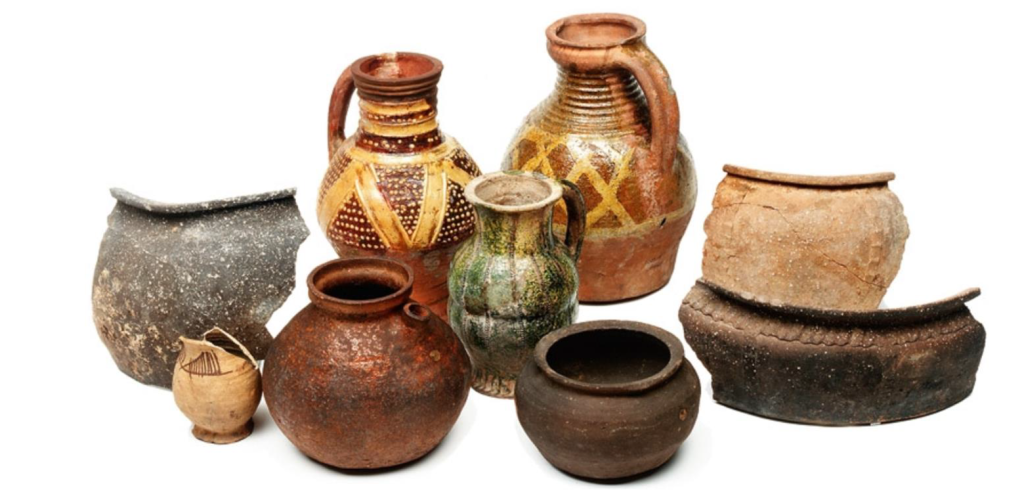
Reference: A dated type series of London medieval pottery: Part 5, Shelly-sandy ware and the greyware industries 2010, Lyn Blackmore, Jacqueline Pearce.
4
HADAS Excavation at ‘Hopscotch’ 88 High St, Barnet EN5 5SN (Part 5 the finds – Ceramic Building Material, (Tim Curtis and Andy Simpson) Site code OPS22
BRICKWORK
Complete or partial bricks (BRIC) were recovered from three of the five contexts. With the sheer amount of CBM on site, especially red tile fragments, which made removing the top two contexts in particular mainly with mattock and shovel quite hard work, only a limited sample of each type of CBM was recovered. See also the ‘Tudor style’ bricks collected by the site owners in earlier articles.
CONTEXT 001 (The ‘topsoil’ layer)
Included a ‘half brick’ of very dense fabric with no frog; also a single fragment of coarse creamy fabric brick with one smooth face and possibly burnt; and seven miscellaneous fragments of presumed modern red fabric bricks, well fired. There was also a single fragment of vitrified brick in a very dense fabric, with one recessed face.
Below this was context 002, with a single fragment of very rough fabric hand-made brick, with small possible flint inclusions and possible sooting on one face, with a matching broken off corner fragment. There was also an almost complete hand-made glazed brick mortared on the base, possibly reused.
There were no brick fragments recovered from context 003 which contained some medieval pottery.
Context 004 was the footings of a relatively modern brick foundation wall, from which one red fabric brick, 8.5x4x2 inches, was retained as a sample. It had traces of mortar top and bottom from when it formed part of the wall foundation.
The bottom most recorded context, 005, containing some medieval pottery, contained no recognisable brick fragments, only unidentifiable small fragments of Nib or Peg (NIPE) tile.
TILE
The vast majority of CBM recovered from the site was red tile of differing types.
Possibly among the most modern material were the ten fragments, totalling 325 grammes, of grey roofing slate fragments from context 001.
Also relatively modern were the fragments of glazed ceramic wall tile (WALT) (pictured below) from context 001 – 16 fragments of white ribbed ‘Pilkington’ tile, a single fragment of a similar type of white smooth tile, one corner fragment of a brown tile with floral design, and four miscellaneous fragments of white and cream wall tile all typical of kitchen or bathroom use.
Also assumed to be relatively modern is a single fragment of chimney pot, wall thickness a half inch, slightly sooted on both faces, and slightly curved – possibly forming the base of a rim.
A further relatively modern find in context 001 was the single fragment of drainpipe (DRAN), wall thickness a half inch, in surface glazed stoneware.
5
A single fragment of DRAN was also found in context 003, possibly of a nine- inch diameter pipe, in a hard fired grey-black fabric.
Also exclusive to context 001 were the fragments of mortar, possibly from a wall surface, with traces of keying on the inner face and whitewash on the outer face, plus brick mortar and two flat slabs of mortar with traces of brick on the underside.
PEG TILE (PEG) All from Context 002 unless otherwise stated.
One particularly fine piece recovered was the top half of a seemingly hand-made tile with three surviving straight edges and two peg holes. It had traces of mortar on the upper and lower faces and a slight curve. Measured 6 ¼ wide and a half inch thick. There was also the top one third of a tile in red fabric with one surviving peg hole and much mortar on both faces, measuring 5 ½ x 6 ½ x ½. inches.
One possible fragment of PEG tile from context 003, being a small corner fragment with possible peg hole, plus one more definite PEG fragment with a single hole. Both were 15mm thick.
NIPE (Nib or Peg tile)
This is the term used for small fragments of tile which due to missing distinctive features cannot be firmly identified as either Peg (PEG) or Nib (NIB) type tiles.
Context 001 included a sample of 17 fragments of NIPE tile with an average thickness of half an inch.
Two red fabric fragments were recovered from context 002, and none from contexts 003 and 004.
Bottom-most excavated context 005, as well as medieval pottery, yielded seven small fragments of unidentified NIP/NIPE/ PEG red tile, all with one very rough face. (Pictured below).
These consisted of two conjoining fragments, with a dark red core and another with a reduced grey core; one notably hard fired fragment, one with an unidentified moulding mark and two large fragments with an edge, noticeable flint inclusions, in a paler fabric than all the others.
CURVED TILE (CURV)
Two fragments from context 002, in a red fabric.
WORKED STONE
Perhaps the most notable item was from context 003 – a small but weighty fragment of worked stone, presumed to be limestone, with one dressed face, weighing 1,011g – the heaviest single fragment recovered from the site (photo below). It could perhaps be part of a window mullion or door surround, and it is tempting to link it to the much-rebuilt Barnet Church just a few yards away to the west.
6
Basement Room
Working behind the scenes, HADAS members are getting ready for forthcoming exhibition at Hendon Town Hall, more details to follow. We also working to get ready for the open day on 16th September at Avenue House- see page 2 If you interested in getting involved on the day let us know.
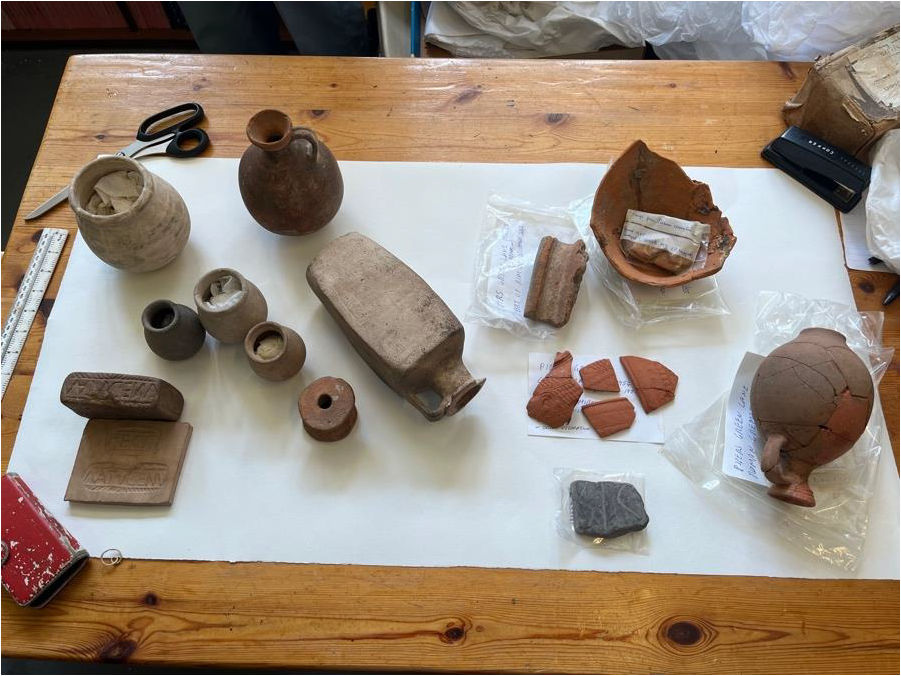
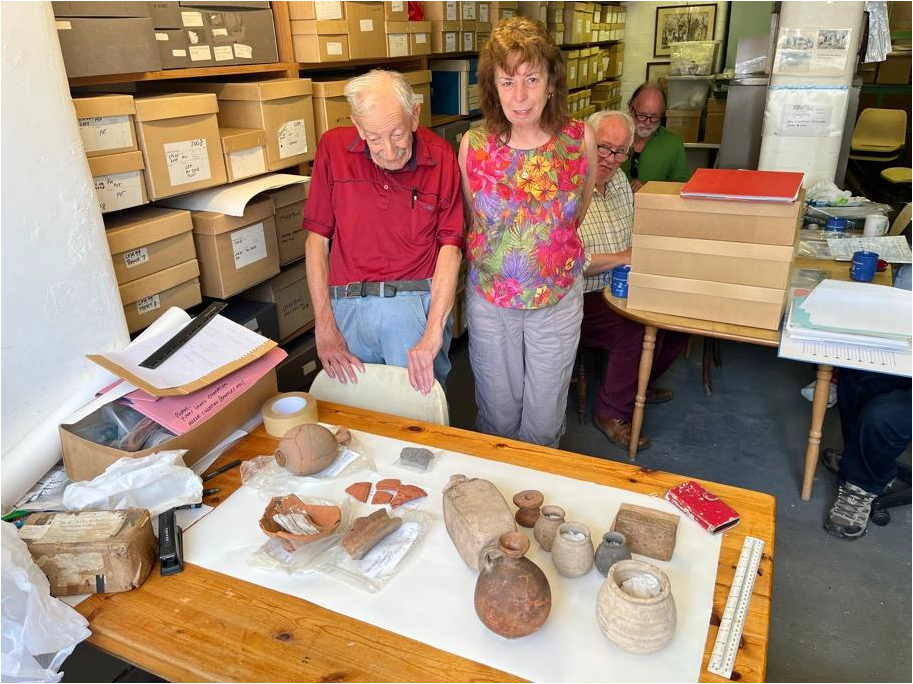
7
Barnet Medieval Festival
HADAS at Barnet Medieval Festival on the weekend of 10th-11th June 2023 at Byng Road playing fields.
Thanks to Bill Bass,, Don Cooper, Melvyn Dresner, Jim & Jo Nelhams, Peter Nicholson, Any Simpson and Ted for giving up so much time attending our stall. A number of other members also visited.
The Festival Website – https://barnetmedievalfestival.org/ contains more information and some short videos.
Events at Avenue House
Avenue House has an interesting list of upcoming events on their website, including the HADAS Open Day. For information, see http://www.stephenshouseandgardens.com/visit.
8
Other Societies’ Events Eric Morgan
Not all societies and other organisations have returned to pre -Covid conditions. Please check with them before attending events.
Monday 4th -Friday- 16th July. Society of Antiquaries. Burlington House, Piccadilly, W1J OBE. Archaeo-Sexism Display. Can be visited on Open Fridays, on selected Fridays when the building will be open to the public to view and learn about the history, also at UCL from 19th – 24th July.
9
Also on Tuesday 4th July,1-2pm.The Archaeo-Sexism Exhibition; Challenging Sexism in Archaeology. Talk by Kayt Hawkins (FSA).
Monday 10th July, 8 pm. Please note change of time. Barnet Museum and Local History Society. St. John the Baptist Church, Chipping Barnet, corner High St./Wood Street Barnet, EN5 4BW. Tree dating and what it tells us about the Old Barnet Shop. Talk by Martin Bridges. Please visit www.barnetmuseum.co.uk.
Friday 14th July. William Camden and his World. Full day Conference, For full list of events and to book, please visit www.sal.org.uk/events.
16th July – Enfield Archaeological Society open day ay Elysng Palace dig (10th July to 23rd July) at Forty Hall, Please note that this year’s summer dig in Forty Hall is now fully booked, and they will not be processing further applications for Society membership until the 24th July. Members of the public are of course welcome to drop by and check on our progress, especially on our public open day on Sunday 16th July. https://www.enfarchsoc.org/#news.
The search for the inner gatehouse:
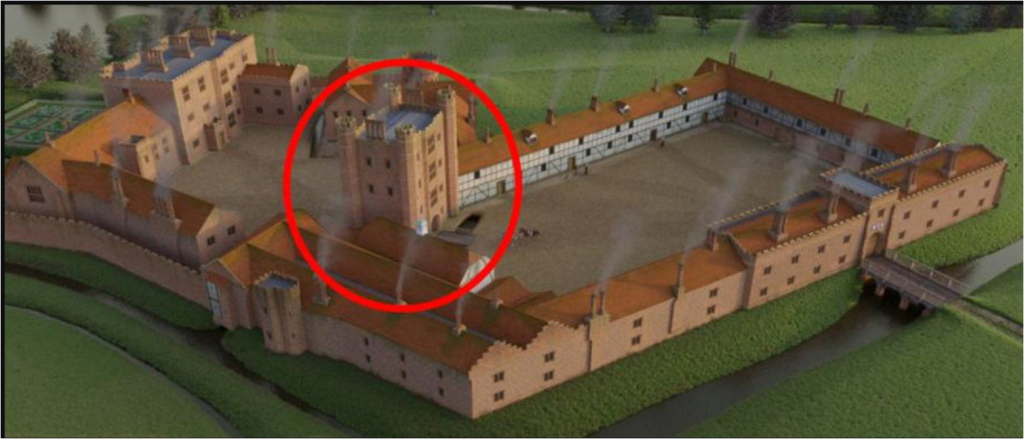
Monday, 17 July 13:00 – 14:00 Willesden Jewish cemetery will deliver a talk at Willesden Green Library, 95, High Road, London, Brent, NW10 2SF, Unveiling the History of Willesden Jewish Cemetery 1873-2023
Monday 17th July 7.15pm. Camden History Society. Hampstead Parish Church. Church Row, NW3 6UU. How our ancestors saw the past. Talk by Gillian Tindall (Vice-president) preceded by AGM. Refreshments 6.45-7.15pm (incl. wine) AGM 7.15pm, Talk 7.45pm.
Saturday 18th July. St Andrew’s Church, Kingsbury Open Day. Church Lane, Kingsbury.NW9 7HE.Part of re-kindling St. Andrew’s Church project., funded by Heritage fund. Big fun day. Willesden Local History Society will have a stall here, alongside Wembley History Society. For more details, please visit www.standrewskingsbury.org.uk/rekindling.
Wednesday 19th July 6pm. Willesden Local History Society. Please note change of address address to Cambridge House,12-16, Cambridge Avenue (not Road) Maida Vale, NW6 5BA. It is a grade2
10
listed building, constructed to descend into the Victorian Ice Wells 1863, in corrugated iron, as St. James’ Episcopalian Church. It was taken on by the Sea Cadets after WW2 and named Training Ship Bicester. It is owned by Notting Hill Genesis Housing Assocn., currently working on conservation. Will visit the History display and learn about its history and plans for its future.
Sunday 23rd July. London Canal Museum.12-13, New Wharf Road, Kings X, N1 9RT.Ice Sunday. Annual day of ice-related activities including an opportunity to descend into the Victorian ice wells beneath the building. Please visit www.canalmuseum.org.uk/.
Thursday 3rd August, 7pm. Avenue House. Take a peek inside. Guided Tour. A rare opportunity to view the house from top to bottom and learn more of its 139 year history and the life of Henry Stephens. Tickets £8. For more info. and booking please visit www.stephenshouseandgardens.com.
Saturday 5th August. Kensal Green Cemetery. Harrow Road, Ladbroke Grove, W10 4RA. Sing a Song of Kensal Green. Musical themed guided tour. For more info visit https://kensalgreen.co.uk.
Sunday 6th August 2.30pm. Heath and Hampstead Society. Sandy Heath and the Heath Extension. Meet at Spaniard’s End (by flower stall and cattle trough) near Spaniard’s Inn, Spaniard’s Road, NW3 7JJ. Walk led by Lynda Cook. Lasts approx. 2hrs. Donation £5. Please contact Thomas Radice on 07941 528034 or e-mail hhs.walks@gmail.com or visit www.HeathandHampstead.org.uk.
Tuesday 8th August 7.45pm. Amateur Geological Society. Finchley Baptist Church Hall, 6, East End Road/ Stanhope Ave.N3 3LX. (Almost opp. Avenue House) AGS Members’ Evening. 3 mini presentations by AGS members and wine and nibbles. Visitors £5 in advance through Mike Howgate at mailto: mehowgate@hotmail.com.
https://amgeosoc.wordpress.com/meeting-dates/.
++++++++++++++++++++++++++++++++++++++++++++++++++++++++++++++++
With many thanks to this month’s contributors: Bill Bass, Melvyn Dresner, Eric Morgan,
Tim Curtis, and Andy Simpson
++++++++++++++++++++++++++++++++++++++++++++++++++++++++++++++++
11
Hendon and District Archaeological Society
Chairman Don Cooper, 59, Potters Road, Barnet EN5 5HS (020 8440 4350)
e-mail: chairman@hadas.org.uk
Hon. Secretary Janet Mortimer, 34, Cloister Road, Childs Hill, London NW2 2NP
(07449 978121) e-mail: secretary@hadas.org.uk
Hon. Treasurer Roger Chapman, 50, Summerlee Avenue, London N2 9QP
(07855 304488) e-mail: treasurer@hadas.org.uk
Membership Secretary Vacancy
While we have no Membership Secretary
for the present, please address any change of member addresses or other miscellaneous correspondence to:
HADAS, c/o Avenue House, 17 East End Road, Finchley, London N3 3QE
Website at: www.hadas.org.uk – join the HADAS email discussion group via the website.
*******************
12

